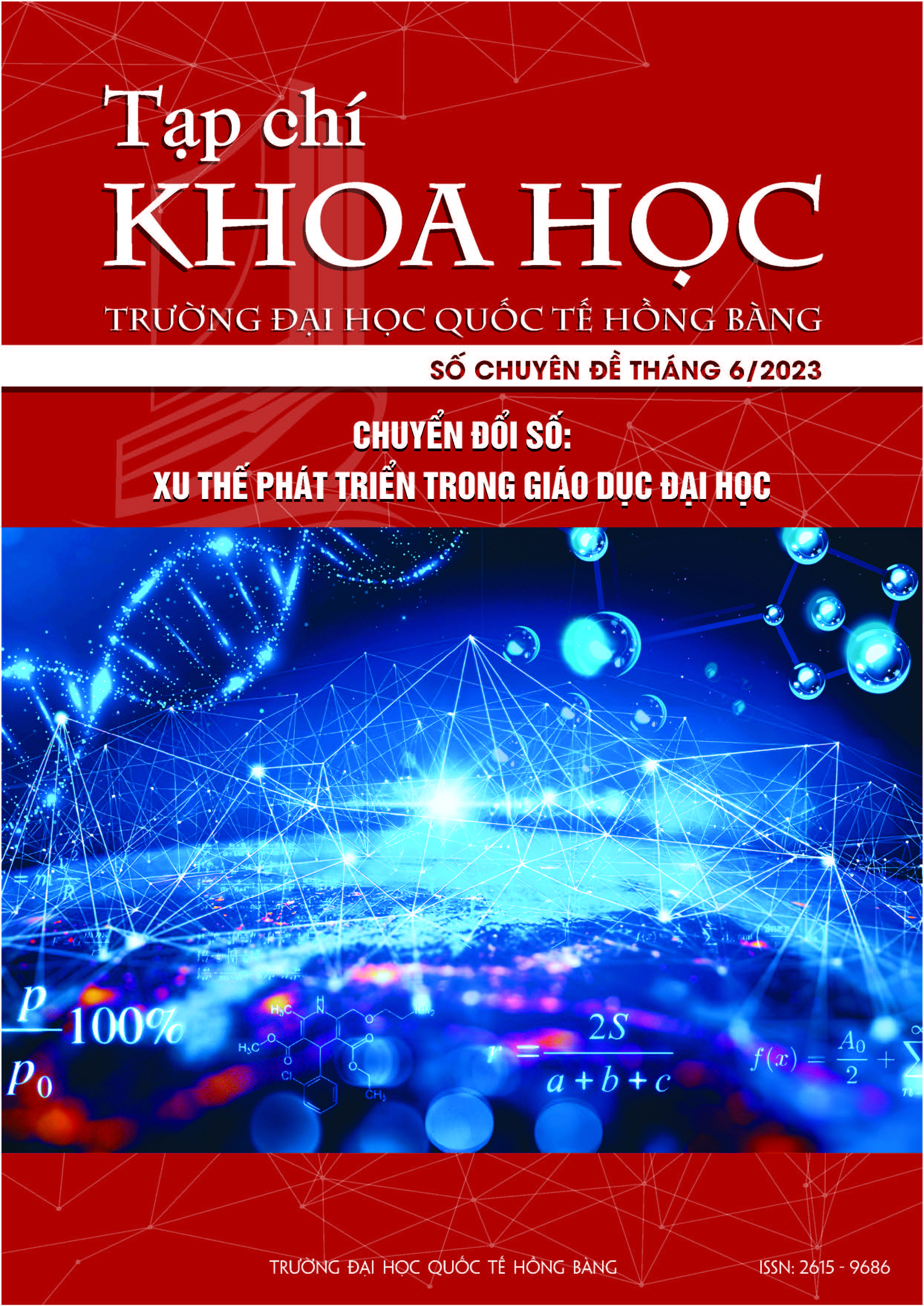Các hệ thống trí tuệ nhân tạo ứng dụng trong giáo dục
Các tác giả
DOI: https://doi.org/10.59294/HIUJS.CDS.2023.359Từ khóa:
Hệ cơ sở tri thức, hệ giải vấn đề thông minh, biểu diễn tri thức, suy diễnTóm tắt
Trong thời đại CMCN 4.0 hiện nay và trong tương lai, chuyển đổi số là xu thế phát triển tự nhiên trong các lĩnh vực hoạt động của con người nói chung và trong giáo dục đào tạo nói riêng, đặc biệt là các ứng dụng của trí tuệ nhân tạo (TTNT). Về mặt khoa học công nghệ, các hệ thống TTNT phổ biến được ứng dụng trong giảng dạy bao gồm các hệ cơ sở tri thức, các hệ giải vấn đề thông minh và các hệ hỗ trợ tra cứu kiến thức, các hệ thống hỗ trợ kiểm tra đánh giá có tính thông minh sử dụng các phương pháp và kỹ thuật của TTNT và hiện nay có cả các chatbot thông minh. Bài báo này sẽ trình bày về cơ sở khoa học cho việc thiết kế một số hệ thống TTNT phổ biến ứng dụng trong dạy và học cùng với một số ứng dụng cụ thể. Các thành phần cốt lõi trong kiến trúc của các hệ thống gồm cơ sở tri thức và bộ suy diễn, sẽ được thiết kế dùng các phương pháp biểu diễn tri thức và suy diễn trên máy tính. Từ đó chỉ ra một tầm nhìn mang tính hệ thống cho việc phát triển các hệ thống ứng dụng theo xu thế chuyển đổi số trong giáo dục đại học.
Abstract
In the era of Industry 4.0 today and in the future, digital transformation is a natural trend in human activities in general, and in education and training, especially with the applications of artificial intelligence (AI). In terms of science and technology, common AI systems used in learning and teaching include knowledge-based systems, intelligent problem solvers, knowledge retrieval systems, and intelligent systems for assessment and testing that use AI methods and techniques, including intelligent chatbots. This article will present the scientific basis for designing some commonly used AI systems in education along with specific applications. The core components of these systems, including knowledge base and inference engine, will be designed using knowledge representation and reasoning methods. This provides a systematic vision for the development of intelligent systems in line with the digital transformation trend in higher education.
Tài liệu tham khảo
[1] Nhon Van Do, “Intelligent Problem Solvers in Education: Design Method and Applications”, In Intelligent Systems, Prof. Vladimir M. Koleshko (Ed.), InTech, 2012.
[2] Đỗ Văn Nhơn, Nguyễn Đình Hiển, Nguyễn Thị Ngọc Diễm, Các hệ cơ sở tri thức, tái bản lần 1. NXB ĐHQG TP.HCM, năm 2022.
[3] Nhon V. Do, “Ontology COKB for Knowledge Representation and Reasoning in Designing Knowledge-based Systems”, Communications in Computer and Information Science 513 – Intelligent Software Methodologies, Tools and Techniques – SoMeT 2014 Revised Selected Papers, Kamido Fujita & Ali Selamat (Eds.), pp. 101-118. Springer International Publishing Switzerland 2015.
[4] Francisco, R. and Silva, F. “Intelligent Tutoring System for Computer Science Education and the Use of Artificial Intelligence: A Literature Review”, in Proceedings of the 14th International Conference on Computer Supported Education (CSEDU 2022) - Volume 1, pages 338-345, SCITEPRESS – Science and Technology Publications, Lda, 2022.
[5] Đỗ Văn Nhơn, Báo cáo tổng kết đề tài NCKH cấp Đại học Quốc Gia TPHCM: Nghiên cứu các phương pháp biểu diễn tri thức cho hệ truy vấn kiến thức Toán hỗ trợ giáo dục đại học, Đại học Quốc gia TPHCM, 2019.
[6] Hien D. Nguyen, Nhon V. Do, Vuong T. Pham, Ali Selamat, E. Herrera-Viedma, “A method for knowledge representation to design Intelligent Problems Solver in mathematics based on Rela-Ops model”, IEEE Access, Vol. 8, pp. 76991–77012, 2020.
[7] Hien D. Nguyen, Nhon V. Do, Vuong T. Pham, “A methodology for designing knowledge-based systems and applications”, In Applications of Computational Intelligence in Multi-Disciplinary Research, Series editor: Valentina Emilia Balas. Elsevier Academic Press, 2022.
[8] N.Đ. Hiển & Đ.V. Nhơn, “Mô hình tri thức toán tử và ứng dụng xây dựng hệ hỗ trợ giải bài toán thông minh”, Tạp chí khoa học và công nghệ, Vol. 52, Number 4D, 2014.
[9] Nhon Van Do, Phat Vinh Huynh, “A Variation of COKB Model for Solving Problems about Chemical Elements”, In Proceeding of 2015 IEEE International Conferene on Knowledge and Systems Engineering (KSE 2015), pp.198-203, Ho Chi Minh City, Vietnam, October 2015.
[10] Đỗ Văn Nhơn, Báo cáo tổng kết đề tài NCKH cấp Tỉnh: Nghiên cứu xây dựng hệ thống hỗ trợ học các môn Toán Trung học cơ sở qua mạng Internet, Sở KHCN Tỉnh Bìng Dương, 2013.
[11] Đỗ Văn Nhơn, Báo cáo tổng kết đề tài NCKH cấp Tỉnh: Nghiên cứu các giải pháp thiết kế và xây dựng phân hệ quản lý tài nguyên học tập cho hệ thống E-Learning, Sở KHCN Tỉnh Bình Dương, 2013.
[12] ThanhThuong T. Huynh, TruongAn PhamNguyen, Nhon V. Do, “A method for designing domain-specific document retrieval systems using semantic indexing”, International Journal of Advanced Computer Science and Applications (IJACSA), Vol. 10, No. 10, pp. 461 – 481, 2019.
[13] Maplesoft, www.maplesoft.com/maple2022, What’s New in Maple 2022, Maplesoft, a division of Waterloo Maple Inc., 2022.
[14] N Mayasari et al, “The Use of Microsoft Mathematics Program toward Students’ Learning Achievement”, Journal of Physics: Conference Series, 1764 (2021). IOP Publishing, 2021.
[15] Junjiraporn Thongprasit et al, “Framework of Artificial Intelligence Learning Platform for Education”, International Education Studies; Vol. 15, No. 1; 2022, Published by Canadian Center of Science and Education, 2022.
Tải xuống
Tải xuống: 1455











